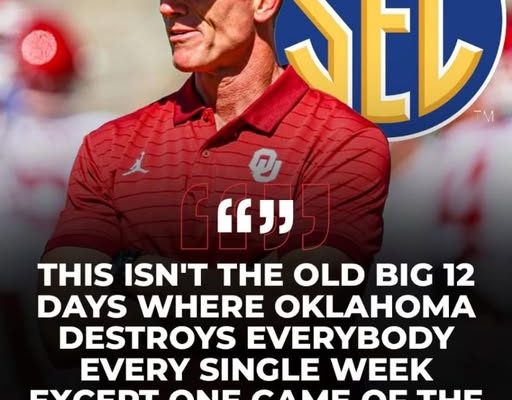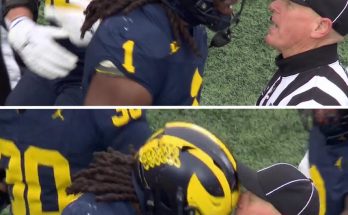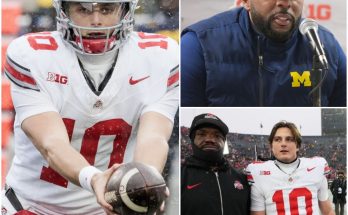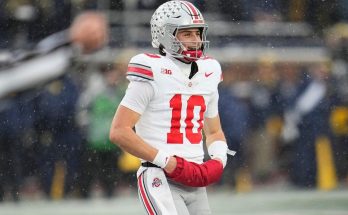Brent Venables arrived at the University of Oklahoma in 2022 amid high expectations, a former Clemson defensive mastermind expected to restore the Sooners to national prominence. His reputation preceded him—Venables had spent nearly two decades under Dabo Swinney, crafting some of the most aggressive, disciplined defenses in college football history. Oklahoma fans, long accustomed to explosive offensive play but defensive vulnerability, saw in Venables a chance to balance the scales. On paper, it seemed a perfect match: a program desperate for defensive stability, a coach hungry to prove himself on a new stage, and a conference in which Oklahoma had long held sway. But as the seasons progressed, it became increasingly apparent that even a coach of Venables’ caliber cannot rest on reputation alone, and the Sooners, for all their history and talent, might have grown a little too comfortable dominating the Big 12.
The Oklahoma Sooners’ dominance in the Big 12 had been nearly unquestioned for decades. Under Bob Stoops, they had won multiple conference titles, consistently competed for national championships, and maintained a level of recruitment that few programs could match. For years, even teams that appeared formidable on paper struggled to keep pace once the Sooners hit the field. But success, as any athlete or coach will attest, can breed complacency. Dominance can mask underlying flaws, and for the Sooners, the comfort of repeated victories may have created an illusion of invincibility that proved difficult to shake. When Venables took over, he inherited a program accustomed to winning, but winning in a system that may not have been as robust as it appeared.
Venables’ initial season was a study in contrast. The Sooners still had the raw talent to overpower opponents, but cracks in discipline and consistency became apparent. It wasn’t just about individual matchups; it was about preparation, focus, and adaptability. Venables, known for his meticulous approach to defensive scheming, attempted to instill a culture that emphasized attention to detail and relentless execution. Yet, ingrained habits are hard to break. Players accustomed to coasting on talent alone needed to adjust to higher expectations, and the results were mixed. Some games showcased a team capable of brilliance, but others revealed vulnerabilities that had been hidden under the cloak of Big 12 dominance.
The challenge for Venables was not merely tactical; it was cultural. Dominance creates expectations, and expectations create pressure. The Big 12 had often been a conference in which the Sooners could rely on their name and history to maintain a competitive edge. Rival programs were strong, but Oklahoma’s talent advantage often smoothed over mistakes that might have been fatal elsewhere. In such an environment, even elite coaching can struggle to make immediate impacts if players are mentally tuned to rely on reputation rather than rigor. Venables’ task was to shift this mindset: to convince players that no opponent should be underestimated, that every game demanded preparation as if it were a national championship, and that small lapses in discipline could have outsized consequences.
In practice, however, that transition has been uneven. Oklahoma has shown flashes of brilliance under Venables’ leadership, moments in which defensive schemes clicked and the team executed with precision. Yet, too often, these moments have been interspersed with lapses that reveal the old habits lurking beneath the surface. It is tempting to blame the players or label certain performances as anomalies, but the underlying pattern suggests a deeper issue: a program that has grown comfortable, even subconsciously, with its dominance. Venables is not immune to this dynamic; coaching a team steeped in historical success requires not just tactical acumen but also psychological insight. Breaking through the complacency barrier is often more challenging than designing a perfect defensive playbook.
One of the most visible indicators of this overconfidence has been the way the Sooners have approached high-pressure games. In contests against programs outside their usual conference opponents, the team has occasionally faltered, revealing a gap between perceived ability and actual performance. Games that should have been routine victories have sometimes become tense affairs, exposing vulnerabilities that opponents can exploit. Analysts and fans alike have noticed this pattern: the Sooners’ talent is undeniable, but their execution is inconsistent, and their mental edge—the kind of confidence that comes from preparation rather than legacy—is still developing under Venables’ watch.
Recruitment patterns also hint at the comfort level within the program. Oklahoma continues to attract top-tier talent, often outpacing other Big 12 programs in sheer star power. However, recruiting alone cannot substitute for development, discipline, or mental toughness. Venables’ emphasis on process over raw ability is a response to this reality, but ingraining a culture of accountability takes time, particularly in a program where winning has often been the default expectation. Players arrive with a sense of prestige, accustomed to accolades and attention, and coaches must find ways to channel that energy into consistent performance. The challenge is not simply identifying talent; it is molding it into a cohesive unit that performs reliably under pressure.
Statistical trends over the past seasons under Venables’ leadership underscore this tension. The Sooners have often dominated in conventional metrics: yards per play, scoring efficiency, and individual performance statistics. Yet, close games reveal a different story. Critical third-down conversions, red-zone defense, and turnover margin have exposed areas where the team’s comfort level might be contributing to lapses. Dominance in standard metrics can mask deficiencies that only emerge under sustained pressure. This is a subtle but significant distinction: a team can appear statistically superior yet falter when circumstances demand resilience, adaptability, and mental toughness.
Another dimension to consider is the evolution of the Big 12 itself. While Oklahoma has historically been a powerhouse, other programs have improved, recruiting more effectively and investing in coaching that narrows the competitive gap. What was once a predictable landscape is now increasingly dynamic, and success no longer comes automatically. Venables’ challenge is amplified by this reality: the Sooners can no longer rely solely on tradition or past dominance. They must adapt to a conference that has grown more competitive, where rivals study game film meticulously and exploit even the smallest weaknesses. In this context, any trace of overconfidence or complacency can be costly.
Off the field, the psychological dimension is equally critical. Players who have grown up in successful programs may unconsciously internalize the expectation of winning rather than the process required to achieve it. Confidence can easily become hubris if not tempered by accountability. Venables has repeatedly emphasized discipline and preparation, yet changing the ingrained mindset of a program takes more than memos or practice adjustments—it requires consistent reinforcement, cultural modeling, and a clear articulation of standards that leave no room for shortcuts.
The media narrative surrounding Oklahoma’s success can also contribute to a sense of comfort. National attention, accolades, and the historical prestige of the program create an environment where failure is often rationalized as an anomaly rather than a reflection of systemic issues. Venables must navigate this narrative, ensuring that players remain grounded and focused on fundamentals rather than reputation. Maintaining humility within a storied program is a subtle but essential leadership challenge, and the ability to do so may define the team’s trajectory under his tenure.
Despite these challenges, there are reasons for optimism. Venables has demonstrated an ability to adapt and refine strategies, adjusting defensive schemes to account for opponent tendencies and player strengths. His experience at Clemson, where he developed elite units capable of thriving under national scrutiny, provides a blueprint for success. The foundation of talent at Oklahoma is undeniable, and the potential for greatness remains intact. The critical task is converting potential into consistent performance, bridging the gap between natural ability and disciplined execution.
The process, however, is ongoing. Teams do not shed habits overnight, and the ingrained comfort of repeated success in the Big 12 is not easily dismantled. Venables’ approach requires patience, persistence, and unwavering commitment to standards that may initially meet resistance. Success will be measured not just by victories but by the consistency of performance, the elimination of mental lapses, and the cultivation of a culture where dominance is earned in every game rather than assumed.
Looking ahead, the Sooners’ future under Venables hinges on several interconnected factors: the continued development of players’ mental and physical discipline, the strategic refinement of schemes to counter increasingly competitive opponents, and the cultural shift required to overcome the comfort of historical dominance. It is a delicate balance, one that requires a coach who can inspire, instruct, and enforce accountability simultaneously. Venables’ track record suggests he possesses the tools, but the path to consistent excellence is rarely linear.
In many ways, the story of Brent Venables and the Oklahoma Sooners is a reminder of a broader truth in sports: talent and history alone cannot guarantee sustained success. Dominance can breed complacency, and even the most gifted coaches must contend with psychological, cultural, and systemic factors that influence performance. Oklahoma’s situation underscores the subtle dangers of comfort—the idea that past victories can substitute for present effort. Venables’ challenge is to ensure that the Sooners’ legacy of excellence is matched by a present-day commitment to rigor, discipline, and resilience.
As the seasons progress, the Sooners’ trajectory will likely be shaped by their ability to internalize these lessons. Games will test not only skill but mindset, and the team’s response to adversity will define the program’s identity under Venables. The narrative of dominance in the Big 12 is evolving, and the Sooners must evolve with it, embracing the reality that every opponent, every play, and every moment demands attention, effort, and focus.
Ultimately, the lesson is clear: Brent Venables’ arrival brought promise, expertise, and high expectations, but the reality of coaching a historically dominant program reveals that comfort can be as dangerous as any opponent. The Sooners have talent, tradition, and a coach capable of excellence, but translating those assets into consistent performance requires more than reliance on past dominance. It requires a cultural shift, mental toughness, and an unwavering commitment to preparation. Success is never guaranteed, and even the most storied programs must confront the subtle complacency that can accompany long-term supremacy.
Oklahoma’s journey under Venables is ongoing, a case study in the interplay between talent, culture, and coaching. The team’s potential remains enormous, but realizing it fully will depend on confronting the comfort of historical dominance and embracing the hard work, focus, and discipline necessary for sustained success. In the end, the Sooners’ challenge is universal in competitive sports: to win not because it is expected, but because every player, every coach, and every game earns it through effort, preparation, and unwavering focus. For Brent Venables, the mission is clear, the stakes are high, and the path forward demands both tactical brilliance and cultural transformation—a test of leadership as rigorous as any on the field.



